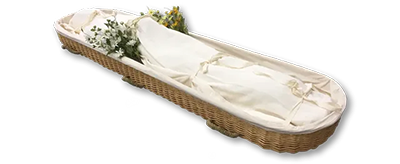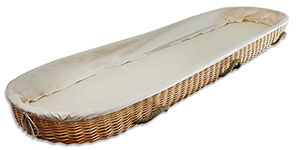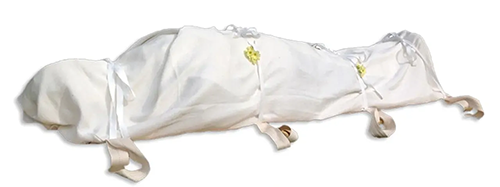Burial Shrouds & Carriers for a Green Burial
A green shroud will be made of natural materials such as cotton, linen, hemp, wool, or silk.
Green Burial Carriers and Shrouds: An Eco-friendly Farewell
Green burial shrouds and carriers are the simple and organic choices to safely and naturally transport your person to a cemetery or interment site. A natural shroud for burial is made from a responsibly sourced textile material and burial carriers are built with sustainable, renewable, and biodegradable materials, making them excellent choices for eco-friendly burials.
But families can provide their own natural material clothing if they prefer. Organic clothing materials could include 100% organic cotton, hemp, wool, or bamboo.
The Philosophy of Green Burials
Increasingly, individuals and families are choosing to honor the cycle of life in a way that underscores their commitment to environmental stewardship. At the heart of this movement are green burials, a practice that embodies sustainability, simplicity, and respect for nature. Green burials, Minnesota has become a particular focal point for this emerging trend, largely due to its flourishing natural landscapes and the environmental consciousness of its residents.
The essence of a green burial lies in minimizing environmental impact by forgoing traditional embalming processes, utilizing biodegradable burial containers, and choosing a natural setting for the final resting place.
Green burial options range from biodegradable caskets to burial shrouds.
Green Burial Caskets and Carriers
For those considering a green burial casket, the materials chosen are eco-friendly and designed to return to the earth gracefully. Green burial caskets are crafted from sustainable materials such as willow, bamboo, or seagrass. These materials are not only environmentally friendly but also add a unique, handcrafted aesthetic to the burial process.
Natural burial in MN and beyond can also involve the use of green burial carriers. These carriers, much like caskets, are designed from biodegradable materials like woven willow. Green burial carriers provide a dignified and respectful way of transporting the body and are open on the top, making the shrouded form of the body visible, which can create a more honest and emotionally impactful burial ceremony.
Burial Shrouds and Their Importance
Burial shrouds hold an equally significant place in green burials. A shroud for burial is a large piece of cloth in which the body is wrapped before burial. For Interra green burial in Minnesota, when a shroud is preferred we generally recommend a shroud and carrier combination where the base is made of willow and the shroud is either a cotton or bamboo material.
Green burial shrouds are always made from materials that are both natural and biodegradable. They're designed to disintegrate over time, leaving no trace of their existence and allowing the body to return naturally to the earth. Cotton, wool, and bamboo are common fabric choices for green burial shrouds.
Cotton is a soft, natural fiber that biodegrades readily in the earth. Wool, on the other hand, is often chosen for its symbolic connection to protection and care. Bamboo, a sustainable and fast-growing plant, provides a silky texture for shrouds and is praised for its eco-friendliness.
History of Burial Shrouds
Burial shrouds have a long and complex history, appearing in various forms and practices across different cultures and religions over thousands of years. The use of shrouds can be traced back to some of the earliest human societies.
Prehistoric and Ancient Times
Burial shrouds have been found at numerous archaeological sites around the world. For instance, burial shrouds were used in Ancient Egypt, where bodies were wrapped in linen shrouds before being mummified. These early shrouds served both practical and symbolic purposes: they helped to preserve the body, but they also signified a connection between life and death, as the wrappings represented the clothes the deceased wore in life.
Classical Antiquity
In Ancient Greece and Rome, shrouding the dead was also common. The shroud often doubled as a winding-sheet to enclose the body, and as a burial garment. It was typically made of white wool or linen. The Roman custom of "sudarium" or "sweat cloth" involved a piece of cloth used to wipe the face of the deceased and was then buried with them.
Middle Ages and Renaissance
In medieval Europe, shrouds were made from various materials, ranging from simple linen for common folk to more elaborate silk for the wealthy. By this period, the church had become more involved in burial practices, with consecrated shrouds offered for those who could afford them.
Judaism: In Jewish tradition, the "tachrichim" or burial shrouds are white, simple, and handmade, symbolizing equality in death. This practice continues today, with the dead carefully washed and dressed in the shroud by the Chevra Kadisha, the Jewish burial society.
Christianity: In Christianity, burial shrouds have a significant role due to the association with the Shroud of Turin, believed by many to be the cloth in which Jesus was wrapped after crucifixion. Traditionally, Christians also used shrouds, often white linen, to wrap the dead, which later evolved into the current practice of dressing the deceased in their personal clothes.
Islam: In Islamic tradition, the deceased is wrapped in a simple white shroud, or "kafan," following a ritual cleaning of the body. This is consistent with the Islamic value of simplicity and humility in death.
Modern Times: In the 19th and 20th centuries, the use of burial shrouds diminished in Western cultures, replaced by the practice of dressing the deceased in personal clothing and the use of elaborate caskets. However, in recent years, there has been a resurgence of interest in green burials and simpler funeral practices, which includes the use of biodegradable burial shrouds.
It's important to note that practices can vary significantly depending on cultural, religious, regional, and personal beliefs. The history of burial shrouds illustrates the wide array of human customs and practices surrounding death and the afterlife.
Shroud Natural Burial: A Connection to Earth
The choice of a shroud for natural burial can offer a profound sense of connection to the cycle of life and death. It provides an intimate and unencumbered return to the earth. A green burial shroud simplifies the burial process and reduces the environmental footprint of the farewell.
Whether you are considering a green burial in Minnesota or anywhere else, the use of a burial shroud or a green burial carrier can provide an eco-friendly, meaningful, and symbolic way to say goodbye. These options align with the principles of minimalism and sustainability, reducing our impact on the planet even in our final act.
The shift toward green burials, shrouds, and carriers is a testament to our evolving understanding of death and our place in the natural world. In returning to these traditional and natural burial practices, we can celebrate life while respecting and preserving the environment for future generations.






